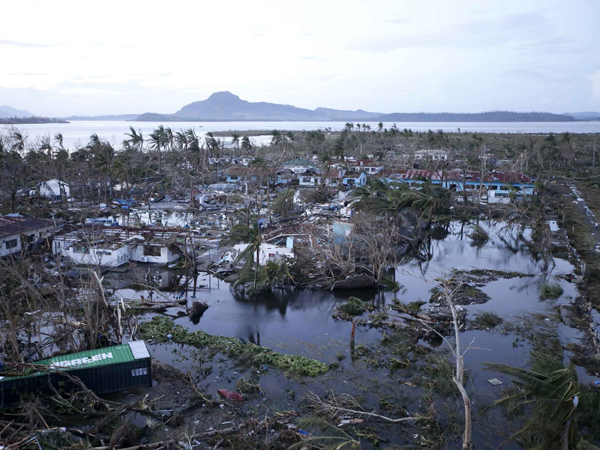SE Asian gov’ts told: Prepare citizens for worsening natural disasters

Tacloban city, devastated by powerful Typhoon Haiyan, is seen in Leyte province, central Philippines Saturday, Nov. 9, 2013. AP File Photo
International experts have urged governments in Southeast Asia to prioritize creating climate change resilience for their citizens, as the region faces more destructive natural disasters due to global warming.
The disaster has displaced millions of people from their homes and left them in poverty and insecurity.
They said “climate refugee” was an emerging, serious crisis confronting humanity in the 21st century because the worsening climate change scenario would intensify natural disasters around the world, not only displacing people from their habitats but also devastating important agricultural areas and harming food security.
A researcher on climate change from Stockholm Environment Institute, Andrea R Torre, said last year’s figures on migration and climate change in Southeast Asia showed the region had suffered the most from natural disasters.
About 8.6 million people forced to migrate due to weather hazards in 2017 were from Southeast Asia, about 46 per cent of the total number displaced.Major natural disasters took the form of floods, typhoons, earthquakes, volcanic eruptions, drought and landslides that posed a hazard to habitat and the livelihood of people in Southeast Asia, notably in Indonesia and the Philippines.
Article continues after this advertisementTorre said natural disasters had already become the biggest reason for mass migration worldwide, not only in Southeast Asia. The Internal Displacement Monitoring Centre (IDMC) revealed that 61 per cent of new displacements in 2017 had been triggered by natural disasters, surpassing warfare and political conflict, which contributed to only 39 per cent of mass migration.
Article continues after this advertisementAccording to the IDMC, in 2017 alone more than 18.8 million people across the world were forced to migrate due to natural disasters, while weather-related hazards contributed to a majority of the migration from disaster – 8.6 million people globally were displaced by floods and 7.5 million people were displaced by storms.
Out of the overall disaster-related displacements, China had the highest proportion of new victims, at 4.4 million people. The Philippines ranked second with more than 2.5 million displaced by disasters last year. Meanwhile, it was estimated that up to 50,000 people also had to leave their homes due to natural disasters last year in Thailand.
“With the intensifying climate change, extreme weather will be more common, which in turn will contribute to greater impacts on a higher number of the population, especially the people living in vulnerable areas of disasters and consequences of climate change such as Mekong River Delta and Chao Phraya River Delta,” Torre said.
She said more severe floods, drought, storms, salinity intrusion and increasing seawater levels are among the major environmental threats to these fertile lands that also have a very high population density.
’Prepare for the worst’
“If we fail to mitigate climate change, more and more people will become climate refugees in the future – it is very important for the governments of every country, especially in Southeast Asia, to develop climate resilience among their citizens and prepare for the worst outcomes for coming disasters,” she added.
Emma Porio, professor of Sociology at Ateneo de Manila University in the Philippines, revealed that not only did the refugees from natural disasters face distress from displacement, they were also driven into poverty and insecurity in every aspect of their lives.
Porio said that after the devastation caused by Typhoon Haiyan and Tropical Storm Kai-tak, the heaviest-hit population group was the poor, as they had to relocate from their destroyed hometowns to Manila and ended up in desperate and overcrowded slums in the Manila metropolitan area.
“The quality of life of these displaced people was drastically degraded, as most of them do not have access to basic education, healthcare, and employment, which drives them deeper into poverty,” she said.
“Therefore, the government needs to prioritize mitigating this issue and come out with strategies to handle displacement from disasters and prevent social insecurities among the refugees from climate change by empowering the communities to have more ability to cope with more intense disasters.”